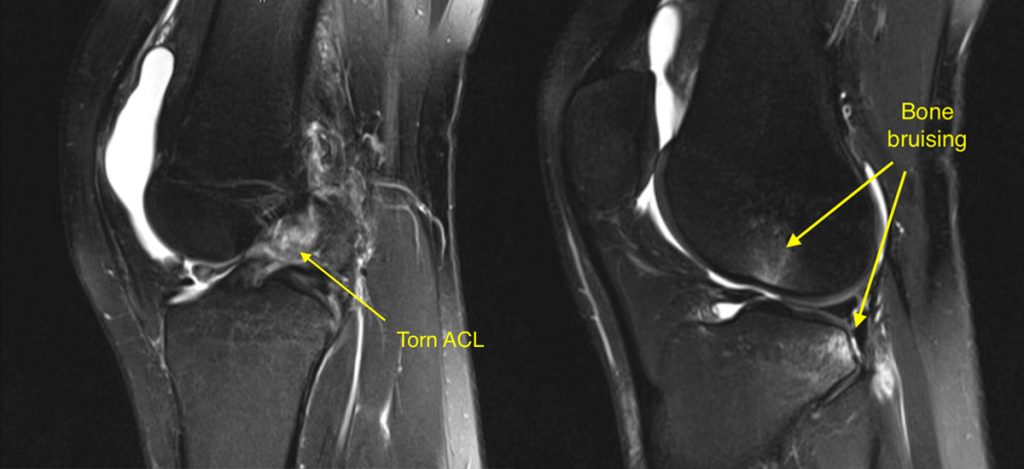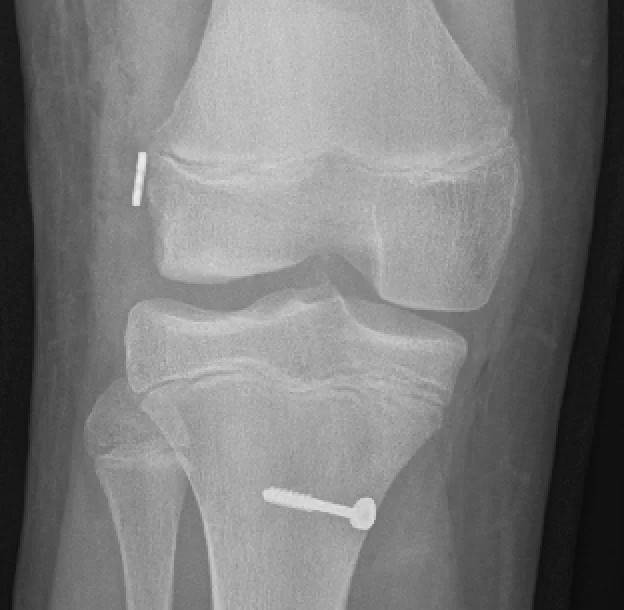ACL TEARS
The anterior cruciate ligament (ACL) is one of the four essential ligaments of the knee. It connects the tibia to the femur in a region called the intercondylar notch.
The primary function of the ACL is to prevent the tibia from moving forward on the femur. Large forces pass through the knee in certain activities. These activities include sudden stopping, sudden change of direction, and jumping and landing on one leg. If these forces exceed the strength of the ACL, then the ligament may rupture. One of the most common knee injuries is an ACL sprain or tear.
SPORTS AND YOUR ANTERIOR CRUCIATE LIGAMENT (ACL)
Many sports are “at-risk” of tearing the ACL. These sports include Australia’s most popular games, Australian Rules football and netball. They also include other sports that involve running, twisting and jumping such as soccer, rugby and basketball. Snow skiing is also an activity that puts the ACL “at-risk”. The ACL can also be torn in other sports and also in non-sporting activities. Even though football is a contact sport, most injuries do not involve contact. A collision will result in more extensive damage involving other structures.
Female athletes have a higher risk of ACL injuries than male athletes due to differences in physicality and neuromuscular control. Others have suggested that differences in leg and pelvic alignment, ligament laxity, and the influence of estrogen on ligament properties are also risk factors for women.

ACL tears are prevalent. They are a significant injury, and some patients may require surgery. Dr Brown will use minimally invasive surgery to speed recovery and allow you to get back to full activity, as soon as possible.
Call us on (03) 5223 3151 Book an appointment today.
ACL INJURY SYMPTOMS
Anterior cruciate ligament injuries may be caused by the following:
A swift change in direction
Suddenly stopping while in motion
Slowing down when running
Improper landing from a jump
An external blow, force or collision, such as during a rugby or football tackle
When the ACL tears, the person may report that their knee gave way or even dislocated. There is often quite intense pain that may settle down relatively quickly. About two-thirds of people hear or feel their knee “pop” or “crack” or even a series of “pops”. Most people cannot walk or bear weight after. Also, the knee swells either immediately or within a few hours. This acute swelling is due to bleeding into the knee joint.
It is possible for the swelling to go away on its own. However, if you try to go back to playing sports, you may risk further knee damage, leading to more serious knee injury. You may also experience a loss of full range of motion, and discomfort when walking.
ACL INJURIES IN YOUNGER PATIENTS
We now see more ACL tears in children and adolescents. The reasons for this are not clear but are several factors are thought to be responsible. An ACL reconstruction in a younger person is associated with some special considerations. As children or adolescents are growing, they have open growth plates. “Growth plates” are a unique structure that occurs at each end of the long bones, which allow for growth of that bone. Drilling of the tunnels would typically pass through the plates. Therefore special consideration of these growth plates needs to occur. People under the age of 18 also have a higher rate of re-injury of their ACL graft. For this reason, graft selection is essential, and often the quadriceps tendon is used instead of the hamstrings. Sometimes the ACL graft needs to be reinforced by what is called a lateral extra-articular tenodesis (LEAT).

HOW SERIOUS IS TEARING AN ACL?
If the ACL is completely torn, there will be knee instability that can cause a sensation of buckling or shifting. It is important to elevate the leg right away, and reduce the inflammation by applying ice and by taking knee pain relievers like Ibuprofen.
Once torn, an anterior cruciate ligament cannot regrow or heal on its own. However, ACL tears can be cured over time. With surgery and physical therapy, it is possible for you to regain full function of your knee. The treatment will depend on the severity of the knee injury and the patient’s activity level.
TYPES OF ACL TEARS
There are two types of ACL tears: partial tears and complete ACL tears.
Partial Tears
Also known as a grade 2 sprain, a partially torn ACL happens when the ligament is stretched too much, becoming loose and damaged. It is not always necessary to perform surgery on a partial ACL tear and it is possible to recover from it with clinical orthopaedic rehabilitation.
Complete ACL Tears
A complete ACL tear is also known as an ACL rupture or grade 3 tear. This means that the anterior cruciate ligament has been split in two. A person with a complete ACL tear may not be able to walk or tolerate weight on the injured leg.
ASSOCIATED KNEE INJURIES
Apart from ACL tear, injury to other structures in the knee are relatively common. About a third of people also tear one or both meniscus. Depending on the direction of force, other ligaments can be damaged, typically the MCL (medial collateral ligament). MRI also demonstrates severe bone bruising. Also, the articular cartilage of the knee can be damaged or even break off.
The posterior cruciate ligament (PCL) is located inside the knee, just behind the anterior cruciate ligament. It connects the femur or thigh bone to the tibia or shin bone. The posterior cruciate ligament prevents the tibia from moving backward on the thigh bone. An intense force or blow can cause an injury to the posterior cruciate ligament, such as when a player falls on a bent knee. PCL injury may also be caused by a twisting injury or contact injury.
Orthopaedic surgeon and sports medicine physician Dr. Graeme Brown provides comprehensive care and treatment for patients suffering from an ACL tear and related knee injuries. He specialises in surgical and non-surgical treatments for a broad spectrum of orthopaedic conditions.
Call us on (03) 5223 3151 Book an appointment today.
The lateral collateral ligament is another ligament that is prone to tears among athletes. It comprise a band of tissue on the outside part of the knee, and links your lower leg bones to your thigh bone and prevents your knee joint from bending outward. The lateral collateral ligament also allow you to bend your knees sideways.
LCL tears happen during hard contact, a sudden change of direction, twisting, bending and jumping. Its symptoms include pain, swelling, tenderness and bruising at the site of the injury. An LCL tear is most likely to occur with an anterior cruciate ligament tear.
ASSOCIATED KNEE INJURIES
We now see more ACL tears in children and adolescents. The reasons for this are not clear but are several factors are thought to be responsible. An ACL reconstruction in a younger person is associated with some special considerations. As children or adolescents are growing, they have open growth plates. “Growth plates” are a unique structure that occurs at each end of the long bones, which allow for growth of that bone. Drilling of the tunnels would typically pass through the plates. Therefore special consideration of these growth plates needs to occur. People under the age of 18 also have a higher rate of re-injury of their ACL graft. For this reason, graft selection is essential, and often the quadriceps tendon is used instead of the hamstrings. Sometimes the ACL graft needs to be reinforced by what is called a lateral extra-articular tenodesis (LEAT).

HAVE YOU DAMAGED YOUR ACL?
If someone suspects that they may have torn their ACL, they should seek urgent treatment. I teach training doctors that if someone is playing one of the “at-risk” sports and has a knee injury, that they have an ACL injury until proven otherwise. The standard first aid for these injuries is RICE (rest, ice, compression and elevation). Often the knee is immobilised in a brace for comfort. However, prolonged immobilisation can lead to knee stiffness. It is, therefore, imperative to start range of motion exercises as soon as possible. Often crutches are required, but early weight-bearing is beneficial.
CAN AN ACL TEAR HEAL WITHOUT ORTHOPAEDIC SURGERY?
It all depends on how severe the tear is. Minor sprains can heal with physical therapy and non-surgical procedures. However, complete ACL tears cannot heal without ACL surgery. The general recommendation is for athletes to seek surgery as soon as they rupture their ACL. This can prevent further injuries to the cartilage and meniscus, and ultimately, the development of osteoarthritis.
WHAT TO EXPECT DURING YOUR CONSULTATION
During your consultation, your doctor will ask about your symptoms and your medical history. He will conduct a physical examination of your injured knee. Imaging tests like X-rays and magnetic resonance imaging (MRI) to help your doctor see if other injuries to surrounding bones or soft tissue are associated with the ACL tear.
Learn more about the ACL procedures that we offer by visiting the ACL Tears Treatment page below.

